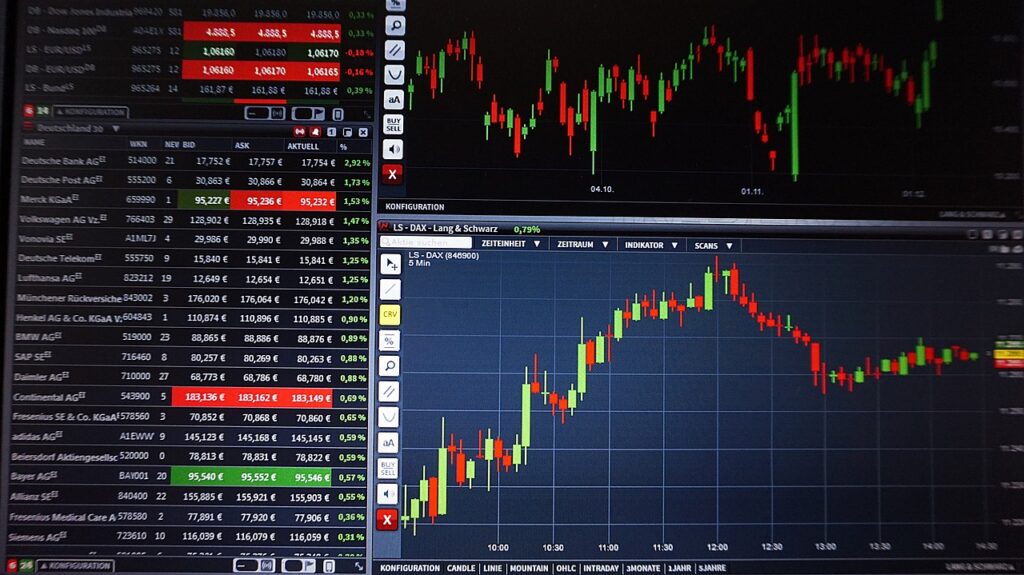To predict currency movements in the Forex market, you should analyze key economic indicators, technical trends, and market sentiment. If you’re looking to deepen your involvement, you might consider how to start a forex brokerage to provide more advanced services and insights. Focus on GDP growth, interest rates, employment data, and trade balances, as these largely influence currency strength. Utilize technical tools like moving averages and oscillators to identify trading patterns. Pay attention to market sentiment indicators and geopolitical factors, as they can create volatility. Combining these analyses allows for more informed trading strategies. If you want to refine your approach further, consider exploring various techniques and strategies that can enhance your market insights.

Table of Contents
Understanding Currency Pairs
When you explore the Forex market, understanding currency pairs is essential, as they form the basis of all trading activities. Currency pairs consist of two currencies, with the first being the base currency and the second the quote currency. The value of the pair reflects how much of the quote currency is needed to purchase one unit of the base currency.
Analyzing currency correlation is vital for effective trading. A high positive correlation means that two currencies move in tandem, while a negative correlation indicates they typically move in opposite directions. For instance, if you trade EUR/USD and notice a strong correlation with GBP/USD, you might anticipate similar movements, allowing for strategic positioning.
Additionally, pair volatility plays a significant role in your trading decisions. Volatility measures how much a currency pair fluctuates over time. Higher volatility often presents greater trading opportunities but also increases risk.
Key Economic Indicators
Understanding currency pairs sets the stage for grasping how key economic indicators influence Forex trading. These indicators provide essential insights into a country’s economic health, impacting your trading decisions.
Economic growth, often measured by GDP changes, signals a robust economy, prompting currency appreciation.
Interest rates, set by central banks, directly affect currency values. When rates rise, investors seek higher returns, increasing demand for that currency. Conversely, lower rates can lead to depreciation.
Inflation rates also play an important role; as prices rise, purchasing power declines, often leading to central bank interventions.
Employment data reflects the overall economic climate. Strong job growth indicates a thriving economy, boosting consumer confidence and currency strength.
Trade balances, showing the difference between imports and exports, affect currency supply and demand. A surplus typically strengthens a currency, while a deficit may weaken it.
Monetary and fiscal policy decisions influence these indicators. For instance, expansionary monetary policy can lead to inflation, affecting currency values.
Technical Analysis Techniques
Technical analysis techniques offer essential tools for evaluating Forex market movements. By analyzing chart patterns and using trend lines, you can identify key support and resistance levels that influence price behavior, helping you spot trends and reversals. Moving averages smooth price data to clarify underlying trends, while oscillators like the Relative Strength Index (RSI) indicate overbought or oversold conditions, guiding entry and exit points. Fibonacci retracement levels highlight potential reversal zones based on historical price movements. Candlestick patterns reveal market sentiment and potential shifts in direction. Volume analysis confirms price movements, and indicator convergence—when multiple indicators align—enhances the reliability of your trading signals.
Sentiment Analysis in Forex
Understanding market sentiment indicators is crucial for predicting currency trends in Forex. By analyzing these indicators, you can gauge trader attitudes and reactions, which often precede significant market movements. Sentiment surveys and social media analysis reveal the collective mood of traders, helping to identify bullish or bearish tendencies. Evaluating sentiment divergence—where market sentiment and price movements don’t align—can signal potential reversals. For example, if traders are optimistic but prices are falling, it might indicate an impending downturn. Sentiment analysis also helps you understand currency correlations; strong sentiment in one currency can affect related currencies. Integrating sentiment analysis with other data-driven approaches enhances your ability to make informed trading decisions and anticipate market shifts.
Geopolitical Factors Impacting Forex
Geopolitical factors greatly influence the Forex market, shaping currency values and trading strategies. Understanding these elements is essential for predicting currency movements.
Geopolitical risks, such as conflicts in conflict zones or shifts in international relations, often lead to currency volatility. For instance, if a nation faces political instability or uncertainty—like during election outcomes—traders may react swiftly, causing significant fluctuations in currency values.
Trade agreements can also play a pivotal role. Favorable agreements tend to strengthen a nation’s currency, while economic sanctions can diminish it. These sanctions not only affect the targeted country but can also influence surrounding economies, creating a ripple effect.
Additionally, diplomatic tensions can lead to regulatory changes that impact Forex markets dramatically.
Developing a Trading Strategy
Creating a successful trading strategy involves blending technical analysis with an understanding of fundamental factors. Start with technical analysis tools: chart patterns, trend lines, and moving averages can reveal trends and potential price movements. Use oscillators to gauge momentum, volume analysis to confirm price moves, and Fibonacci retracement levels to identify support and resistance. Candlestick formations and divergence signals offer insights into market sentiment and potential reversals. Complement this with fundamental analysis by tracking interest rates, trade balances, government policies, employment data, and political events, as these factors influence currency values and market sentiment. Implement robust risk management techniques such as stop loss orders, appropriate position sizing, and maintaining a favorable risk-reward ratio. Be cautious with leverage and manage drawdowns to protect your capital. Combining these elements will help you develop a balanced and effective trading strategy.
Conclusion
In the dynamic forex market, predicting currency movements hinges on a blend of analysis techniques. By understanding currency pairs, monitoring key economic indicators, employing technical analysis, and gauging market sentiment, you can enhance your trading strategy. Additionally, staying alert to geopolitical factors can provide vital insights. Ultimately, a data-driven approach allows you to make informed decisions, adapt to market shifts, and improve your chances of success in trading currencies.





